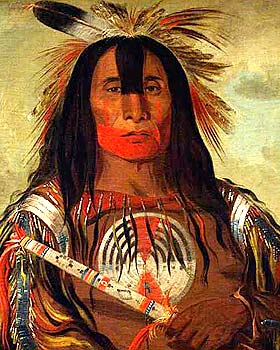Welsh Indians? Dylan Thomas, Richard Burton, and Cochise? Sorry, ain't seeing it, and I have a hard time imagining anybody ever could. But some did. The Madoc-Mandan yarn is one of many far-fetched stories about European or even extraterrestrial origins for indigenous American culture, the idea evidently being that actual Native Americans were too backward to have come up with this stuff on their own. The Welsh angle is distinguished mainly by its persistence, having bubbled up like swamp gas for more than 400 years. I have no illusions about being able to stamp it out now. But it lacks any basis in fact.


3 comments:
Interesting.
I trust you know the Pueblo Indians don't like the term "Anasazi" anymore (because it means "enemy" in Navajo). They prefer the term "Ancestral Puebloans."
I haven't heard that theory before. Do you have any evidence of it? I mean scholarly research and the like?
You might want to publish your findings as a scientific paper. I imagine it would be quite the bombshell. No doubt the thousands of Indian and non-Indian scholars who have concluded that the Pueblo people were the direct descendants of the "Anasazi" would be interested in the results.
I don't know about you, but I've focused on the Pueblo people in my 15-plus years of research. I must've read several dozen books on them, including many of the major ones. Yet somehow I've missed the theory that there was no connection between the Pueblo and Anasazi people.
According to this posting (May 2006), archaeologists have found exactly six cases of polydactyly among the ancient people of the Southwest. Six? That's not enough to conclude anything, which is why the scientists have just begun to speculate that the trait may have been commonplace.
Of course, any conclusion would have to take into account the probability that six-fingered individuals were buried more often than five-fingered individuals--because they had either more or less social status than average. Right? Because it would be ridiculous to assume that five-fingered and six-fingered individuals died and were buried at exactly the same rates.
I trust you can point me to all the studies that have addressed these issues before rendering their verdict. I await the evidence with bated breath.
There's a huge amount of continuity between the Ancestral Puebloans and the modern-day Pueblos in terms of architecture, agriculture, pottery, basketry, symbols, etc. I can't repeat or remember everything I've read on the subject, but here are a few starter links for people:
http://en.wikipedia.org/wiki/Anasazi
http://www.glencanyonassociation.org/history/native.php
http://www.crowcanyon.org/EducationProducts/archaeologists_online/03_ancient_pueblo.htm
If you don't think there's any connection between the "Anasazi" and today's Pueblos, how do you explain the clear cultural continuity? You'd have to come up with a valid explanation for why the Pueblos share so many traits with the Anasazi despite the alleged lack of continuity.
As for your three specific points:
1) The Anasazi culture obviously broke up and dispersed (or died). The Anasazi people may have--indeed probably--merged with other tribes in the area. So the Pueblos may be descended from other cultures as well and these other cultures may predominate in their history.
In any case, given the well-established decimation of the Anasazi, I'm not surprised that much of their cultural knowledge was lost. That's only natural in times of great stress and change. How many cultural achievements did the Romans retain after the Huns sacked their city, for instance?
2) The whole Pueblo culture, especially in the western Pueblos such as Hopi, revolves around bringing rain to the land. The Pueblos have lots of symbols for rain, clouds, and lightning. In fact, you might have trouble finding a complex piece of Pueblo art (e.g., painting, pottery, or regalia) without sky-related symbols.
Some links on the subject:
http://americanart.si.edu/education/guides/pueblo/pueblo_symbols.cfm
http://www.ancestral.com/cultures/north_america/hopi.html
"Rain cloud images are a common motif among the Hopi, and they were often used as signatures by clans and individuals."
http://www.singingstonestudio.com/monumental_sculpture.htm
"This elegant sculpture reflects the Pueblo people’s reliance on the rain clouds. During certain ceremonies the headdress, called a tablita, is worn to represent the clouds. On the reverse side of this sculpture hair flows from the head to the feet. In Pueblo culture the hair represents rain. The engraving on the front symbolizes songs from the ceremonies to induce moisture from the cloud spirits."
I don't know how many symbols the Pueblos would need to prove cultural continuity to your satisfaction, but a lack of evidence isn't very convincing as evidence. As far as I'm concerned, the previous point about cultural decimation is enough to explain any shortcoming in this area.
3) Let's assume the six-digit condition wasn't just some freak occurrence among a few Anasazi families. We still can't conclude much from it. Maybe the six-digited people were a band of outsiders who conquered the Anasazi people and set themselves up as royalty. Maybe they were a band of outsiders whom the Anasazi conquered and put down as slaves. Maybe they were a distinct clan of Anasazi who didn't intermarry with the others because they were considered holy or unholy people (i.e., witches).
Until you can disprove such possibilities, the alleged trait of polydactyly is almost worthless as evidence of cultural continuity. If this is all you have, I wouldn't confront the Pueblo people just yet and tell them their beliefs are wrong. I'd wait until your case is much stronger than it seems to be now.
Post a Comment